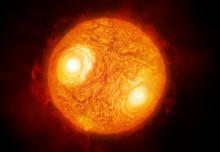Listen to today's episode of StarDate on the web the same day it airs in high-quality streaming audio without any extra ads or announcements. Choose a $8 one-month pass, or listen every day for a year for just $30.
You are here
Moon and Antares
Antares is a big spotlight. Not only is the star a brilliant beacon on its own, but it also lights up the stuff around it. In particular, it’s illuminating the Rho Ophiuchi complex — clouds and ribbons of gas and dust that are giving birth to more stars.
The complex is about 460 light-years away. Few stellar nurseries are closer. It’s named for one of the bright stars it’s created.
The complex consists of several clouds, plus some streamers that are dozens of light-years long. They’re sculpted by winds and radiation from hot, bright stars.
Some of the clouds and streamers reflect light from Antares and other big, bright stars. Others are energized by the stars, so they produce their own light. And still others remain dark — they’re dense and cold.
Those regions are where most of the new stars are being born. Astronomers have cataloged thousands of stars and potential stars there. Some have not yet flared to life. Others are no more than a million years old. The most massive will live short, brilliant lives, then blast themselves to bits — the same fate that awaits Antares in the next million years or so.
Antares stages a spectacular encounter with the Moon tonight. They climb into good view by about 1 a.m. Antares snuggles within a degree or so of the Moon. The Rho Ophiuchi complex spans about a dozen times the size of the Moon. It’s so faint that it’s best seen in photographs — lit up in part by bright Antares.
Script by Damond Benningfield



